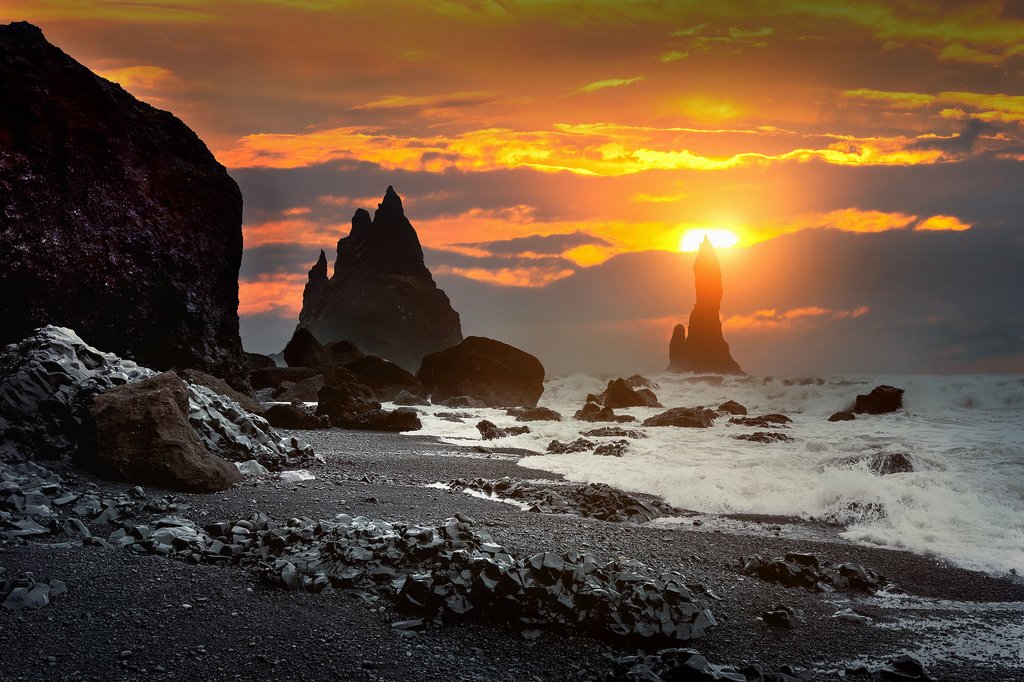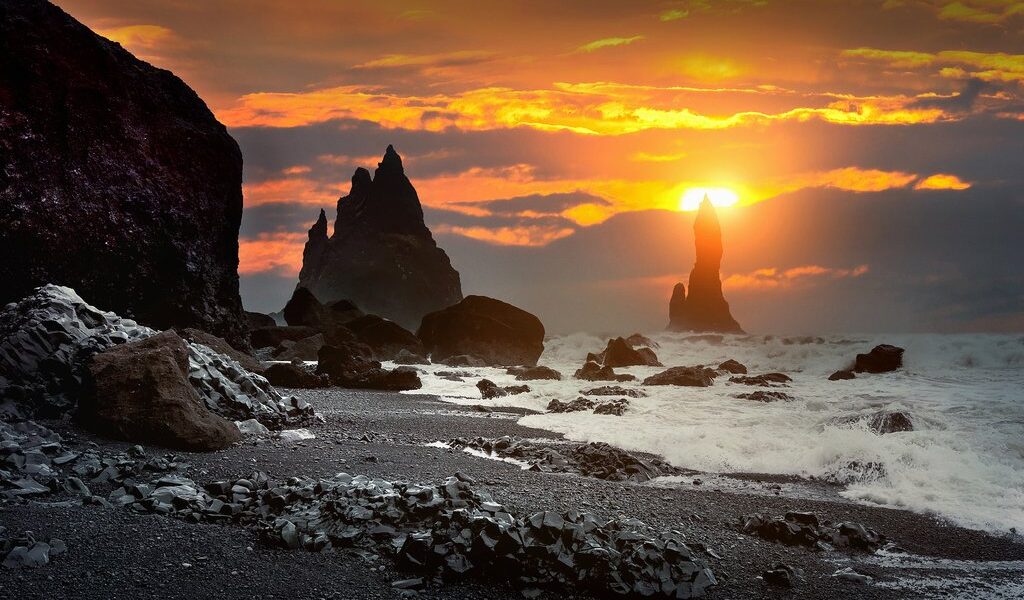
With few crowds, low prices, and ever-increasing daylight hours, March is arguably one of the best times to visit Iceland. Enjoy all the winter tours in peace and still have plenty of opportunities to catch the Northern Lights. Find out what to do and where to go with this March guide.
Iceland in March: A Comprehensive Guide
March in Iceland marks a transition, a delicate dance between the lingering embrace of winter and the tentative promise of spring. The days begin their gradual stretch, offering between 10 and 13 hours of daylight, a welcome change after the darker winter months. However, don’t be fooled by the increasing sunlight – the weather in Iceland remains delightfully unpredictable. Temperatures typically hover between 28 and 38 degrees Fahrenheit, but these numbers tell only a fraction of the story. Be prepared for a whirlwind of conditions, experiencing sunshine, snow, rain, and wind, perhaps all within a single day.
While March often represents the last hurrah for significant snowfall, the warming influence of the Gulf Stream ensures that rain is a common visitor, particularly along Iceland’s southern and western coasts. Preparing for this climatic variety is key to a comfortable and enjoyable trip. Essential items include thermal layers to keep you warm, along with a high-quality windproof and waterproof jacket to shield you from the elements. Sturdy, waterproof boots are also a must, ensuring your feet stay dry and comfortable as you explore the diverse landscapes.
Despite the unpredictable weather, much of Iceland remains accessible in March. However, it’s vital to stay informed about potential road hazards. Unexpected weather can significantly impact driving conditions, so it’s crucial to check road closures and weather forecasts regularly. Factor in extra travel time to account for potential delays, ensuring a safe and stress-free journey to and from your chosen attractions.
Crowds and Costs in March
March presents a unique opportunity to experience Iceland with a sense of tranquility. As it’s still considered off-season, you’ll encounter far fewer tourists compared to the bustling summer months. This quieter atmosphere allows for a more intimate and immersive experience, enabling you to truly connect with the country’s natural beauty and culture.
Beyond the reduced crowds, March also offers significant cost savings. Flights, car rentals, and accommodations are typically priced lower than during peak season, making it a budget-friendly time to visit. However, remember that the possibility of inclement weather necessitates flexibility in your travel plans. Always verify road conditions and be prepared to adjust your itinerary as needed to ensure safety and enjoyment.
Where to Embark: Exploring Iceland’s Gems
The majority of travelers begin or conclude their Icelandic journey in Reykjavík, the vibrant capital city. Reykjavík is a hub of creativity, boasting cutting-edge architecture, unique boutiques, and an array of trendy restaurants. The city also serves as an excellent base for exploring nearby natural wonders and popular attractions.
Venture beyond Reykjavík to discover other charming towns. Just a short distance away lies Hafnarfjörður, a town steeped in Viking history, offering a glimpse into Iceland’s rich past. Kópavogur is another noteworthy destination, renowned for its Art Museum and the chance to spot adorable seal pups along its coastline.
For those seeking to explore further afield, the coastal towns of Seyðisfjörður on the eastern coast and Húsavík in the north are highly recommended. Seyðisfjörður captivates with its picturesque scenery and artistic atmosphere, while Húsavík is known as the whale watching capital of Iceland and a great starting point for exploring Diamond Circle, Iceland’s northern sightseeing route. Both towns provide access to excellent hiking trails, allowing you to immerse yourself in Iceland’s stunning natural beauty.
Take advantage of the reduced tourist numbers in March to explore the iconic Southern Coast. This region encompasses the renowned Golden Circle, a must-see for any visitor. The Golden Circle includes Þingvellir National Park, a UNESCO World Heritage Site where the North American and Eurasian tectonic plates meet; the Geysir Geothermal Area, home to Strokkur, a geyser that erupts every few minutes; and the majestic Gullfoss waterfall, one of Iceland’s most iconic landmarks.
The Southern Shore route is equally captivating, featuring the imposing Eyjafjallajokull glacier, the cascading Seljalandsfoss and Skogafoss waterfalls, and the dramatic black-sand Reynisfjara beach, located just outside the charming village of Vík. Each of these locations offers a unique and unforgettable experience.
If a snowy landscape is what you desire, consider a short flight to Akureyri, a delightful town nestled in northern Iceland. Akureyri is brimming with boutiques, restaurants, and bars, offering a taste of Icelandic culture and hospitality. It is also conveniently located near some of the country’s best ski slopes and breathtaking natural scenery.
Unforgettable Activities in March
Even with increasing daylight hours, March remains an excellent time to witness the mesmerizing Northern Lights, especially around the Spring Equinox. To maximize your chances of seeing this celestial display, rent a car or join a guided tour to escape light pollution and find the darkest skies.
Consider embarking on a cruise from Akureyri into the serene waters of the Eyjafjörður fjord, or sailing into Faxaflói Bay, situated between the Reykjanes and Snӕfellsnes peninsulas. Wildlife enthusiasts and photographers will be thrilled by the opportunity to observe pods of orcas that frequent the Icelandic coast during this time.
Escape the wind and venture into an ice cave or lava tube. These subterranean wonders are adorned with intricate ice formations, creating a truly enchanting experience. Viðgelmir and Raufarhólshellir are excellent choices, offering paved and gravel paths for a more comfortable exploration. For the more adventurous, Leiðarendi provides a thrilling experience, requiring sliding, crawling, and scrambling over ice and lava rock.
Enhance your Golden Circle and South Shore itinerary with a glacier hiking tour. Trek up Svinafellsjökull from the Skaftafell Nature Reserve in southwest Iceland. While in the area, explore the ice caves beneath Vatnajökull glacier, the largest glacier in Europe, and visit the Jökulsárlón glacier lagoon, where you can capture stunning photographs of floating blue icebergs.
Remember to maintain a flexible and easygoing attitude, as road closures due to weather conditions are possible.
Festivities and Events in March
Icelanders celebrate **Beer Day** on March 1st, commemorating the legalization of alcohol above 2.2% ABV in 1989. Locals traditionally spend the day enjoying alcoholic beverages with family and friends in local pubs and taverns. A popular choice is Brennivín (“Black Death”), a potent herbal schnapps with a 40% alcohol content.
**Rainbow Reykjavík Winter Pride** is a small, yet vibrant international pride festival that takes place in Reykjavík for three days in the middle of March. The festival highlights Iceland’s captivating attractions alongside the celebration of LGBTQ+ pride.
**Design March** is a festival celebrating the best of Icelandic design, from fashion and furniture to architecture, the environment, food, and product design. Showcasing both local talent and international names, the festival takes place in Reykjavík.
The **Iceland Winter Games**, held annually in Akureyri, began as a single Freeski event and has evolved into a diverse international winter festival. The games feature ski and snowboard competitions (some held on a volcano), dogsledding, Arctic horseback riding, and snowmobile racing, among other exciting activities.
Exploring Iceland with Carefully Curated Itineraries
If you’re looking for a comprehensive overview of Iceland’s top natural attractions, consider the **Classic Circle Tour of Iceland – 9 Days**. A self-drive adventure offers the ultimate freedom to explore at your own pace, with ample opportunities to venture off the beaten path. This tour also includes the Snaefellsnes peninsula, often called “mini-Iceland” due to its diverse landscape that mirrors Iceland’s natural phenomena on a smaller scale.
For an action-packed winter getaway, the **Northern Lights & Snowboarding on Iceland’s South Coast – 6 Days** itinerary is an excellent choice. The South Coast of Iceland offers a wealth of winter activities, from glacier hiking and snowboarding to snowmobiling and more. With a bit of luck, you’ll have the chance to witness the breathtaking Northern Lights dancing across the Arctic sky. This itinerary provides a recommended plan for an unforgettable winter adventure on Iceland’s South Coast.
B-1126

